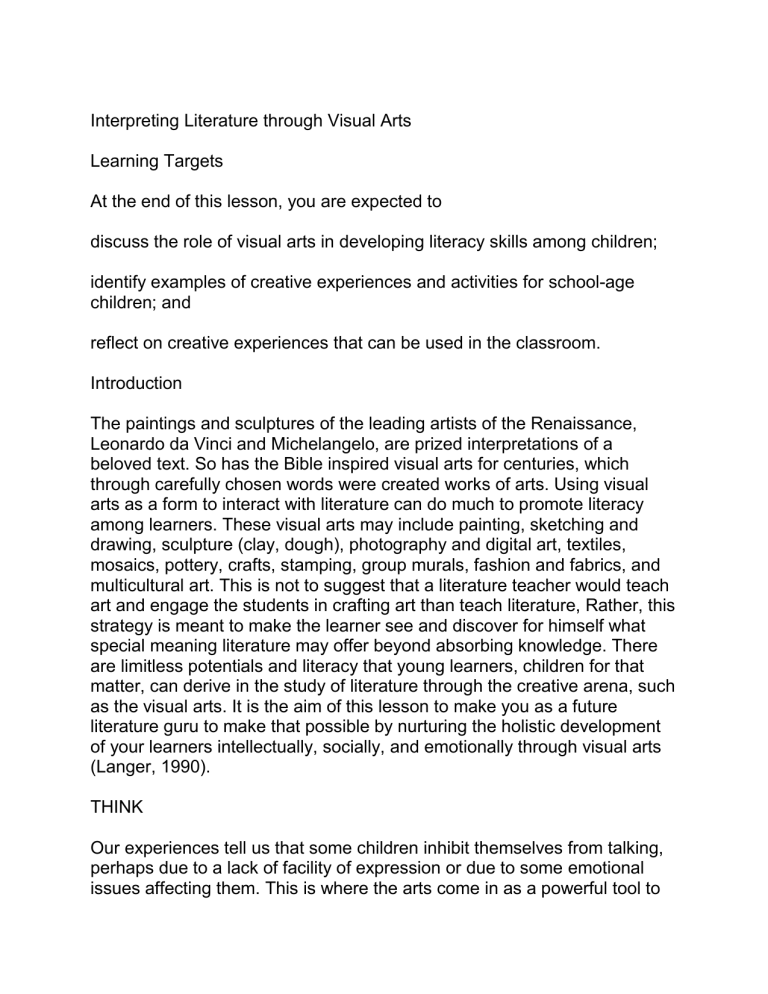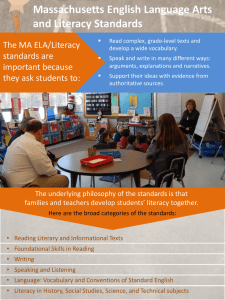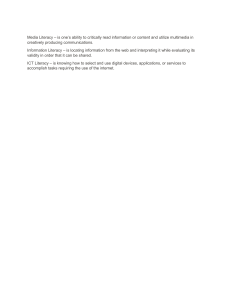Visual Arts in Literacy: Course Module for Elementary Grades
advertisement

Interpreting Literature through Visual Arts Learning Targets At the end of this lesson, you are expected to discuss the role of visual arts in developing literacy skills among children; identify examples of creative experiences and activities for school-age children; and reflect on creative experiences that can be used in the classroom. Introduction The paintings and sculptures of the leading artists of the Renaissance, Leonardo da Vinci and Michelangelo, are prized interpretations of a beloved text. So has the Bible inspired visual arts for centuries, which through carefully chosen words were created works of arts. Using visual arts as a form to interact with literature can do much to promote literacy among learners. These visual arts may include painting, sketching and drawing, sculpture (clay, dough), photography and digital art, textiles, mosaics, pottery, crafts, stamping, group murals, fashion and fabrics, and multicultural art. This is not to suggest that a literature teacher would teach art and engage the students in crafting art than teach literature, Rather, this strategy is meant to make the learner see and discover for himself what special meaning literature may offer beyond absorbing knowledge. There are limitless potentials and literacy that young learners, children for that matter, can derive in the study of literature through the creative arena, such as the visual arts. It is the aim of this lesson to make you as a future literature guru to make that possible by nurturing the holistic development of your learners intellectually, socially, and emotionally through visual arts (Langer, 1990). THINK Our experiences tell us that some children inhibit themselves from talking, perhaps due to a lack of facility of expression or due to some emotional issues affecting them. This is where the arts come in as a powerful tool to help children express themselves what they cannot do in words. When words are hard to come by, creative expressions like drawing, painting, sculpting, or other visual representation of their feelings open child-friendly options and alternatives to enable them to express themselves and to show what they know, thereby paving the way for healthy development and love for learning (Gandini, 1992). 74 A Course Module for Teaching Literacy in the Elementary Grades through Literature Given this golden opportunity to tap the creativity and ingenuity of young minds and to make learning successful, the teacher is advised for that matter not to be overbearing and domineering. Dictating what to do or what to use would, and could, dampen the enthusiasm of the learner, unless it is necessary when it involves developing a skill like sewing or writing an essay where specific skills or strategies need to be taught (Althouse et al., 2003). Analyzing great literature, Zindler (2009) opines, is just like examining great art, and the integration of arts in literature provides opportunities for students on all levels to build strong literary skills as well as literacy skills in writing, speaking, and listening. Just as probing questions are asked in analyzing an art work, probing questions are similarly asked in literature. Probing and analyzing selected works urges one to ask questions, pay attention to details, conjecture and imagine, and to draw insightful conclusions. Also, brainpower is stimulated to make meaning of words and vocabulary. In this manner, as students internalize this habit of mind they develop as readers and gain confidence to handle and delve willingly, eagerly, and enthusiastically into more complex texts to broaden their understanding of the world in unimaginable ways. There is no disputing what Eisner (1998) wrote, "What cannot be conveyed or constructed in words is often possible in visual images..." In "Learning Art, Learning Literacy," DeFord (2014), educators with the expertise and know-how on the interrelationship between arts and literacy examine books of this nature to find out the truth behind Eisner's words. In the first book, "The Power of Pictures," the author explains how teachers can, through arts, urge students, particularly those who encounter difficulties in learning, make great strides in the domains of both reading and writing. Especially with children who do not have the facility of expression, the author shows teachers how teaching literary text through the medium of visual arts, be it a simple art work, can improve cognitive skills and heighten literacy achievement. Given exposure to well-crafted picture books, storybooks, and the like along with the opportunity to dabble in art, these children, oozing with rich imagination and real-life experiences, are able to recognize words and make artistic representations of these. With more encouragement, soon enough they become confident to craft and design their own creative works and literary "masterpieces." In the second book, "Thinking and Learning through Drawing in Primary Classrooms," the author points out how drawing provides the avenue for children to be creative and to express themselves with more freedom and less restraint. Whether they use drawing to express what they feel, what they see, and what they know or to create what their minds conceive, this artistic expression gives children a wider room to see and discover the world from their limited worldview and arm them with the confidence and assurance to be themselves as they grapple to present their own fresh ideas in their art works. The book infuses a new perspective in the teaching of literature by pointing out the uses of drawing as a powerful tool in lending support and encouragement to how children think CHAPTER 3 Interpreting Literary Texts for and with the Children 75 and learn. It equally gives compelling reasons for competent authority to look into how arts, considering their practical uses, merit, and relevance, can be integrated into the curriculum. Arts are a powerful tool for literacy. Smith and Herring (1996) recognize the arts as "hands on" experiences to build problem-solving and critical thinking skills. This is true, as in the case when a student is given an art work to accomplish, and the student has to muster all the skills like critical thinking, decision-making, analysis, focus and concentration, negotiation and bargaining, communication, team work, and collaboration to achieve his purpose. These necessary set skills come to the fore and come in handy on times like this (Siks, 1983). At the same time, this leads the student to a time of reflection, contemplation, and self-awareness. When arts activities are integrated into reading lessons, it is amazing how children do not get tired telling and retelling stories about their experience in creating their art work. This validates what Mathieson (2015), in her action research study, found about the impact of arts activities upon the learners' literacy skills. Catterall (2002) goes further in saying that the satisfaction, fulfillment, and the breadth of experience a learner derives from artistic reasoning, visual arts instruction, and fashioning art works translate into improved writing skills such as organizing and sequencing ideas and interpreting texts or reading between the lines besides enhancing reasoning and way of thinking and eagerness for reading. Other studies also present evidence how the delight and pleasure in art-making experiences encourage students to use and hone their skills in the performance of their tasks aside from intensifying their interest in learning activities. Finally, Fung (2013) in an earlier study, points out how the integration of meaningful and purposeful artworks in the study of literature serves as a fertile ground for innovativeness and creative ideas, in addition to developing and enhancing self-confidence and promoting teamwork and collaboration. It, thus, behooves teachers to impart learning in meaningful ways to make the learner ever willing to learn.




